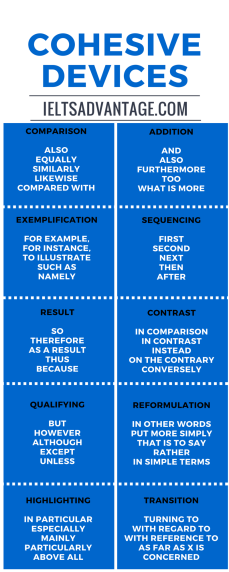 Introduction
Introduction
Cohesive devices, sometimes called linking words, linkers, connectors, discourse markers or transitional words, are one of the most misunderstood and misused parts of IELTS Writing.
Cohesive devices are words like ‘For example‘, ‘In conclusion‘, ‘however‘ and ‘moreover‘. Together with coherence, cohesion provides 25% of your marks in both parts of the Writing test. However, most students have not been taught how to use them effectively.
This post will look at how and, more importantly, when we should use them.
What are cohesive devices?
Cohesive devices tell the reader what we are doing in a sentence and help to guide them through our writing. They signal to the reader what the relationships are between the different clauses, sentences and paragraphs.
Let’s look at two examples below.
- The public transport in this city is unreliable and it’s cheap.
- The public transport in this city is unreliable but it’s cheap.
There are two cohesive devices in the sentences above: ‘and’ and ‘but’. Both give the reader different signals and change the meaning of the sentence.
The first sentence tells the reader that ‘it’s cheap’ is simply being added to the previous information, however, the second sentence tells the reader that they are giving a contrasting opinion to the first part of the sentence by using the word ‘but’.
In other words, the second sentence is saying ‘it’s unreliable (which is bad) but the good thing about it is it’s cheap, so I don’t mind using it.’ Simply using the word ‘but’ conveys that whole message without needing to literally say it.
This makes our message more succinct and our writing easier to read. But, does that mean we should use as many cohesive devices as possible?
Overusing Cohesive Devices
The biggest mistakes many students make is to use cohesive devices in nearly every sentence.
If you look at the IELTS Writing Marking Criteria it states that a Band 7 ‘uses a range of cohesive devices appropriately although there may be some under-/over-use‘. This is typical of a student who knows the meaning and how to use cohesive devices, but thinks that using them as much as possible will get them a high mark.
However, using them too much often leads to students using them incorrectly. It is stated for Band 5 that ‘makes inadequate, inaccurate or over use of cohesive devices‘. In my experience, most students get a Band 5 in this category for this reason. They think that using them as much as possible will get them a high mark, but don’t consider the meaning and how each of them should be used in a sentence.
Band 8 and 9 students tend to only use cohesive devices when necessary and they use them appropriately and effectively i.e. correct meaning and grammar. In fact, many students have criticised Band 9 answers because ‘they don’t have enough discourse markers’. Take a look at the extract below from an academic journal (The Power of Human Rights by Stephen C. Ropp).
This extract is about 200 words long. How many cohesive devices can you see?

Most IELTS students will not be able to produce writing to this very high standard, but you should remember that you don’t get extra marks for lots of cohesive devices, the most important thing is using them accurately (grammar) and appropriately (meaning).
Meaning and Grammar
The next problem students have is learning long lists of cohesive devices and not learning the meaning of each word or how it should be used in a sentence. If you use the wrong word it confuses the reader and this lowers your mark for both coherence and grammar. It is better to use no word than use a word incorrectly.
My advice is to NOT learn long lists of words. The list below is more than you will ever need and learning more than this will probably just confuse you or take up time that could be used to learn something else. In a 250 word essay you might give 2-3 examples at the most, so why would you learn 10 different ways to give an example? You only have one conclusion, so it seems like a waste of time to learn 5 different ways to do this.
Learn just the words you need and learn them 100%. By 100% I mean that you know exactly what that word means, when it should be used in a sentence and how it should be used in a sentence. Until you know all of this 100%, don’t use it.
Finally, don’t try to use very complicated words and expressions, if you are not already comfortable with the simple terms. Being able to use ‘and‘ or ‘but‘ effectively is much better than trying to use more complicated words incorrectly. Again, look at some academic texts or good IELTS sample answers; simple words are used more often than not.
How to Improve
You can’t simply learn a long list of words and then hope you can use these correctly in an essay. That would be like Ronaldo telling you how he scores so many goals and thinking you can do the same thing by just listening to him.
Also, you can’t look at just one example sentence and hope to learn everything you need to know about that word.
If you want to improve do the following:
- Reading is the number one way to learn new words. Good writers read a lot, it’s that simple. Pick a topic you are interested in and read a little every day. 20 minutes is enough. Note down any cohesive devices and how they are used in each sentence.
- Check the meaning and grammar of each word on sites like the British Council or BBC. You will find lots of explanations there and example sentences.
- Practice using these and then have your writing checked by an experienced IELTS teacher.
If you do the following, you will slowly learn how to use cohesive devices effectively. I wish there was a faster way, but like most things in life, hard work and practice is the best and only solution.
Below is a list of more cohesive devices than you will every need to do well on the IELTS Writing test.
 (Nguồn: IELTS Advantage – Christopher Pell)
(Nguồn: IELTS Advantage – Christopher Pell)